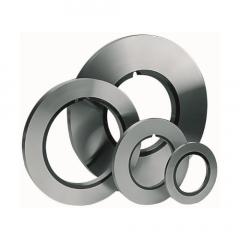Rotary shear cut
Rotary shear cutting refers to slitting metal strips with strip thicknesses of approximately 0.01 to 16 mm and tensile strengths between 300 and 2400 Newton/mm².
DIENES know-how
In contrast to the classic shear cut where top and bottom knife touch each other in the overlap area, the separation in the roller shear cut basically takes place with a cutting gap. Depending on the cutting program, the roll shear knives are additionally equipped with ejector and intermediate rings, each mounted alternately on a lower and upper knive block. The material to be cut is separated by two cutting edges which are offset by a kerf, i.e. penetrate the material from opposite directions without contact. The cutting quality is significantly influenced by the cutting gap. As a guide value for steels and depending on their material strength, this is approx. 10 % of the respective plate thickness. For soft strips such as copper, brass or aluminum, the cutting gap is reduced to approx. 5 % of the respective material thickness.
In order to be able to realize these setting parameters at all, the roll shear knives must be adapted with regard to their tolerances, i.e. thickness, parallelism and flatness. In addition, polished surfaces as well as a material selection matched to the respective material to be cut and its hardness ensure the highest cutting quality.

